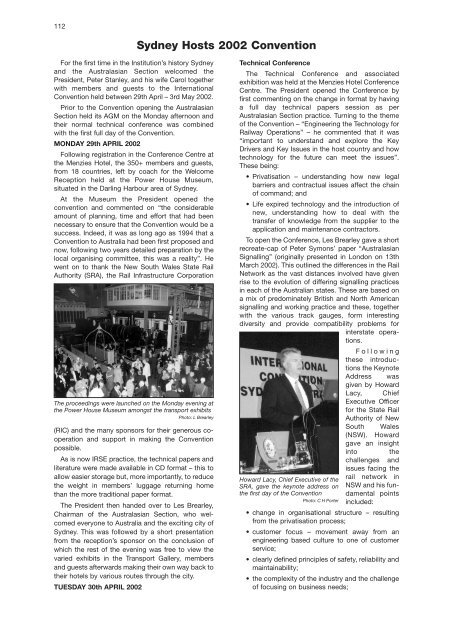Proceedings 2002/2003 - IRSE
Proceedings 2002/2003 - IRSE
Proceedings 2002/2003 - IRSE
Create successful ePaper yourself
Turn your PDF publications into a flip-book with our unique Google optimized e-Paper software.
112<br />
Sydney Hosts <strong>2002</strong> Convention<br />
For the first time in the Institution’s history Sydney<br />
and the Australasian Section welcomed the<br />
President, Peter Stanley, and his wife Carol together<br />
with members and guests to the International<br />
Convention held between 29th April – 3rd May <strong>2002</strong>.<br />
Prior to the Convention opening the Australasian<br />
Section held its AGM on the Monday afternoon and<br />
their normal technical conference was combined<br />
with the first full day of the Convention.<br />
MONDAY 29th APRIL <strong>2002</strong><br />
Following registration in the Conference Centre at<br />
the Menzies Hotel, the 350+ members and guests,<br />
from 18 countries, left by coach for the Welcome<br />
Reception held at the Power House Museum,<br />
situated in the Darling Harbour area of Sydney.<br />
At the Museum the President opened the<br />
convention and commented on “the considerable<br />
amount of planning, time and effort that had been<br />
necessary to ensure that the Convention would be a<br />
success. Indeed, it was as long ago as 1994 that a<br />
Convention to Australia had been first proposed and<br />
now, following two years detailed preparation by the<br />
local organising committee, this was a reality”. He<br />
went on to thank the New South Wales State Rail<br />
Authority (SRA), the Rail Infrastructure Corporation<br />
The proceedings were launched on the Monday evening at<br />
the Power House Museum amongst the transport exhibits<br />
Photo: L Brearley<br />
(RIC) and the many sponsors for their generous cooperation<br />
and support in making the Convention<br />
possible.<br />
As is now <strong>IRSE</strong> practice, the technical papers and<br />
literature were made available in CD format – this to<br />
allow easier storage but, more importantly, to reduce<br />
the weight in members’ luggage returning home<br />
than the more traditional paper format.<br />
The President then handed over to Les Brearley,<br />
Chairman of the Australasian Section, who welcomed<br />
everyone to Australia and the exciting city of<br />
Sydney. This was followed by a short presentation<br />
from the reception’s sponsor on the conclusion of<br />
which the rest of the evening was free to view the<br />
varied exhibits in the Transport Gallery, members<br />
and guests afterwards making their own way back to<br />
their hotels by various routes through the city.<br />
TUESDAY 30th APRIL <strong>2002</strong><br />
Technical Conference<br />
The Technical Conference and associated<br />
exhibition was held at the Menzies Hotel Conference<br />
Centre. The President opened the Conference by<br />
first commenting on the change in format by having<br />
a full day technical papers session as per<br />
Australasian Section practice. Turning to the theme<br />
of the Convention – “Engineering the Technology for<br />
Railway Operations” – he commented that it was<br />
“important to understand and explore the Key<br />
Drivers and Key Issues in the host country and how<br />
technology for the future can meet the issues”.<br />
These being:<br />
• Privatisation – understanding how new legal<br />
barriers and contractual issues affect the chain<br />
of command; and<br />
• Life expired technology and the introduction of<br />
new, understanding how to deal with the<br />
transfer of knowledge from the supplier to the<br />
application and maintenance contractors.<br />
To open the Conference, Les Brearley gave a short<br />
recreate-cap of Peter Symons’ paper “Australasian<br />
Signalling” (originally presented in London on 13th<br />
March <strong>2002</strong>). This outlined the differences in the Rail<br />
Network as the vast distances involved have given<br />
rise to the evolution of differing signalling practices<br />
in each of the Australian states. These are based on<br />
a mix of predominately British and North American<br />
signalling and working practice and these, together<br />
with the various track gauges, form interesting<br />
diversity and provide compatibility problems for<br />
interstate operations.<br />
Following<br />
these introductions<br />
the Keynote<br />
Address was<br />
given by Howard<br />
Lacy, Chief<br />
Executive Officer<br />
for the State Rail<br />
Authority of New<br />
South Wales<br />
(NSW). Howard<br />
gave an insight<br />
into the<br />
challenges and<br />
issues facing the<br />
Howard Lacy, Chief Executive of the rail network in<br />
SRA, gave the keynote address on NSW and his fundamental<br />
points<br />
the first day of the Convention<br />
Photo: C H Porter<br />
included:<br />
• change in organisational structure – resulting<br />
from the privatisation process;<br />
• customer focus – movement away from an<br />
engineering based culture to one of customer<br />
service;<br />
• clearly defined principles of safety, reliability and<br />
maintainability;<br />
• the complexity of the industry and the challenge<br />
of focusing on business needs;

















